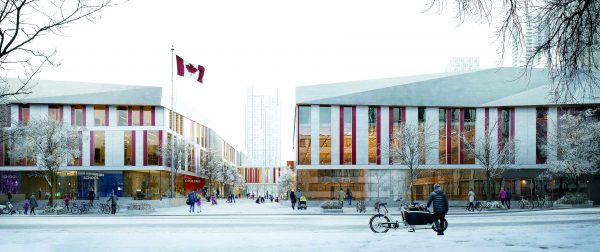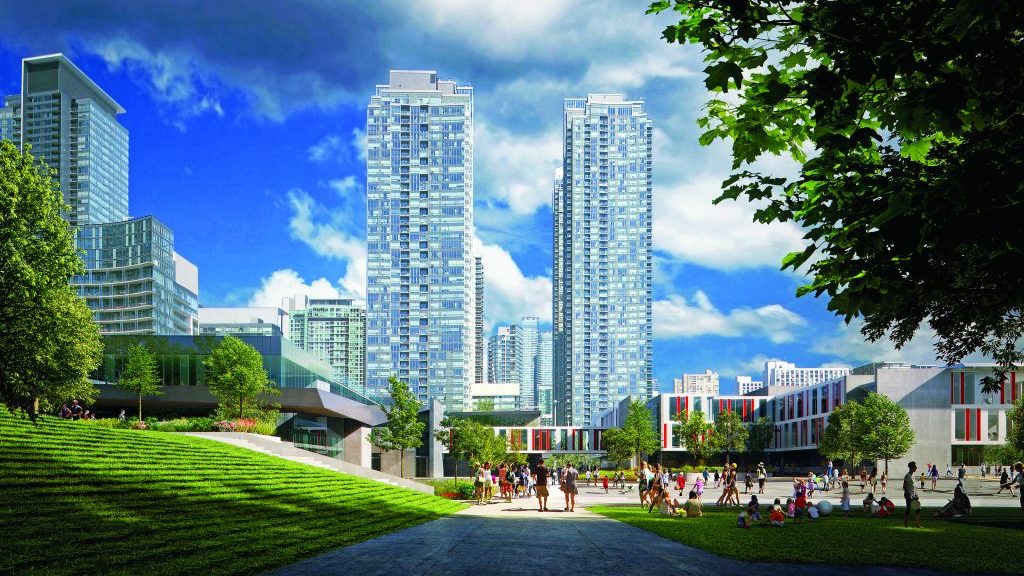A sloping green roof and an accompanying “veil cladding” are the signature pieces of a new facility being built in an almost brand new high-rise community on Toronto’s waterfront near historic Fort York.
Designed by ZAS Architects + Interiors Inc. and being built in joint venture by the Atlas Corporation and Buttcon Limited, the Canoe Landing Community Facility is comprised of a school and a community centre which are structurally independent of each other—other than a connecting steel frame pedestrian bridge and a tunnel. The site is almost immediately adjacent the Gardiner Expressway.
Construction started in late summer 2017 and the steel components, which comprise a significant portion of the complex, are now at a 60 per cent-complete stage, says Mark Campbell, project manager with WSP, the structural consultant.
The community centre is comprised of three levels and an “active” green roof with a steel infrastructure support which required extensive geometric detailing.
This was especially the case in the community centre which accommodates two gymnasiums with two different truss systems for the clear heights required, says Campbell.
Fabricated by Toronto-based Pittsburgh Steel Group, they are comprised of three 20-metre-long, 1.2-metre deep (65-foot-long 3.9-foot deep) trusses which support a mechanical room above one gymnasium and another three, 22-metre-long, four-metre-deep (72-feet-long, 13-foot-deep) trusses in a second north gymnasium to support a green roof, a basketball court, and a suspended running track.

Each of the north trusses weighed 21,000 lbs., while the south ones were 32,000 lbs. each, and both a mobile and tower crane were needed to hoist them into place, says Atlas site superintendent Brad Peddle.
Apart from the trusses, 1,400 beams, columns, and other members have installed and the erection of the structural steel should be competed very shortly.
The centre will then be framed with heavy gauge steel. As for the school to the south, it is primarily a concrete building with beams and joists for the roof, he says.
Like any other project in a tightly congested downtown setting, constructing the facility has it more than its fair share of challenges including scheduling material deliveries and adhering to noise bylaws in a heavily populated residential district, says Peddle.
At the same time the Canoe Landing Community Facility is, in many ways, a very unique project in its financing and form. One hundred per cent financed by levies on the adjacent condominium buildings, the facility will be the “backyard and front yard” for the residents of those towers who live in relatively small units, says ZAS principal Peter Duckworth-Pilkington.
By that description he is referring to features such as a community kitchen, an indoor play centre which was designed in partnership with the Ontario Science Centre, and the green roof which will also include a designated area for yoga in addition to the basketball court.
And the school building is example of co-ordinated planning and cooperation by the City of Toronto, the Toronto District School Board, and the Toronto District Catholic Board to provide educational services in a new community, says the architect.
It will actually house two elementary schools, the Bishop Macdonell Catholic and the Jean Lumb Public Schools, each serving 550 children from kindergarten to Grade 8
“Vertical communities are common in New York, London, and other cities, but are relatively new to Toronto,” says Duckworth-Pilkington, who predicts there will be more to come.











Recent Comments